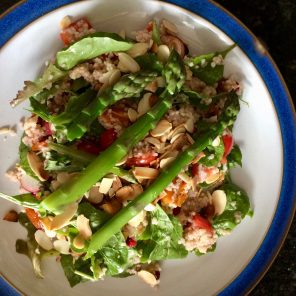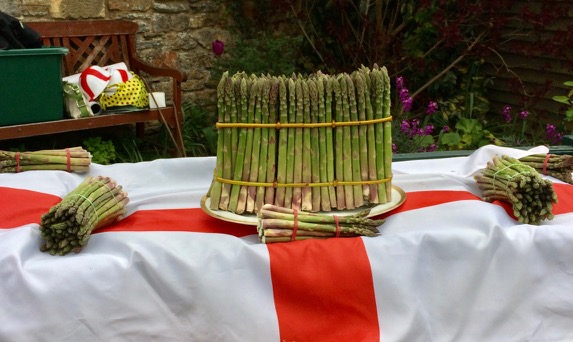I’m standing at the corner of a huge field with Darren Hedges, Asparagus Grower and Revills Farm Shop owner. Bredon Hill is in the distance. There are wide ridges across the field.
So where is the asparagus? Darren suggests I “get my eye in”. The harder I look, the more spears I see poking out of the ground. I then realise the enormous scale that asparagus is grown on a Revills Farm. This is just one of their fields.

I am sure you’re already a big fan of asparagus, I certainly am. So I set out to find out more about this wonderful seasonal vegetable. Come and join me on my journey and finish by enjoying a tasty asparagus salad.
Asparagus has PGI Status
Vale of Evesham asparagus was recently awarded Protected Geographical Indication (PGI) status. Astonishingly only 7 fruit and vegetables (out of 78 in total) have been listed in the UK.

The scheme aims to protect the reputation of regional products and traditional growing methods. In practice, this means that only Vale of Evesham asparagus growers can use the label on their product as it is prepared and processed in the local area.
What to look out for: Vale of Evesham on wrapper round your asparagus.At Revills, much of the asparagus is processed and supplied to Waitrose within a few of days from picking.
The Asparagus Season is 12 weeks long
We’ve much longer to enjoy asparagus. Improvements in varieties mean that the outdoor season now lasts 12 weeks. It usually starts around St George’s Day (rather appropriately for such an English delicacy). Some growers now extend the season even further growing the plant in polytunnels. No need for imports from Peru then ever. Only outdoor grown asparagus is labelled as PGI.
Asparagus is all cut by hand

Can you imagine the quantities? Darren drove me over to a 42 acre field where the asparagus was being harvested. During the 12-week season, asparagus is cut every single day. The plants prefer warm dry weather rather than wet. After 8-10 years the asparagus beds are exhausted. The crowns are removed and the fields are used for other crops.
At the bottom of the field a tractor with a vast “boom” on which baskets are stacked, proceeds sedately up the rows. Ideally, the asparagus field should have a gentle incline for optimum growing conditions.

A team of men were using special asparagus knives to cut the spears. Each bent down cutting a few spears at a time gathering them into the hand selecting those that are exactly the right length (which happens to be the same length as the knife). The spears are cut underneath the soil.

Later I visit the state of the art processing plant. Here asparagus is sorted, graded and packed before distribution. When I ask Darren how long it would take to sort an enormous number of boxes I discovered just a day.
Asparagus does not need cooking
Darren asked if I had ever tasted asparagus raw. I hadn’t. Picking a spear fresh from the ground and tasting is a revelation. Its flavour is reminiscent of fresh peas and utterly delicious and quite different to the cooked flavour. Use the very freshest asparagus you can find before slicing very thinly and adding to salads for maximum flavour.
Asparagus can be green, purple or white

No matter what the colour they are all the same plant. On the continent most of the asparagus you’ll find it white – its grown under the soil and is much fatter and fibrous than green asparagus. Common varieties of asparagus in the UK are Mondeo, Backlim and Ginjlim.
There’s an art to tying asparagus
A special auction is held at the Fleece at Bretforton each year when around a thousand people cram into the 14th-century courtyard to bid for “rounds of grass”. The sale highlight is a “hundred” (in fact 120 spears). Tying these is a real art and few people still have the skill. They are tied in withy stems (willow stalks) which have been made supple by being buried underground over the winter, then stripped to make twine to tie the spears. I had the opportunity to see how individual bunches are tied.
This year MEP Anthea McIntyre hosted a visit to the European Parliament by growers and aficionados from the Vale of Evesham in Worcestershire. Accompanied by mascot Gus the Asparagus Man as well as St George, the delegation delivered asparagus to the EU to celebrate and say “thank you” for the granting of EU Protected Geographical Indication (PGI) status. Later, the parliament’s chef prepared the asparagus for lucky MSPs to eat.
Asparagus is easy to cook
It’s also very good for you including B-complex vitamins and Vitamin K. I think asparagus is best cooked very simply. Hold the spears in both hands and push up gently with your thumbs. The spear will break just above the woody party. There’s no need to peel the spears.
Asparagus Salad with toasted seeds and nuts

This is a versatile dish that you can tweak according to what you have to hand!

Asparagus and Toasted Seed Salad
Ingredients
- 2 handfuls A mixture of green salad leaves. Rocket makes a nice peppery addition
- 50 grams Seeds and nuts (eg sunflower seeds, flaked almonds, pumpkin seeds, poppy seeds, cashew nuts)
- 1/2 Pomegranate Remove seeds
- 10 Cherry tomatoes halved
- 1 bunch Asparagus or 8-12 spears
- 1/2 Lemon squeezed
- 2 tablespoon Oil (olive or rapeseed)
- 120 grams Couscous
- 1 handfuls Chopped herbs Any of coriander, parsley, chives, basil, oregano
- Salt and pepper
Instructions
- For the couscous
- Check the cooking instructions on the packet as different varieties of couscous vary - some you need to soak, others boil. Boil 500 ml of water add the couscous and let it soak until soft adding more water if required. When cooked, add the olive oil and lemon juice. Taste and add salt and pepper to taste then set aside to cool.
- Lightly toast the seeds and nuts in a dry pan. Keep your eye on them so they do not burn. Set aside.
- Bring a pan of water to the boil. Add a small pinch of salt. Snap the asparagus, discarding the woody ends. Add to pan and cook for 4-5 minutes until tender but not very soft.
- Plunge into cold water for a 20 seconds in a sieve to stop the cooking. Then drain.
- Assemble your salad
- Add the chopped herbs to the couscous mixture. Taste and adjust seasoning. Add the pomegranate seeds and the nut/seed mixture.? Lastly add the leaves and tomatoes and mix well. Top with the asparagus?, Serve with fresh bread - foccacia is ideal.

Find out more
- There’s a fascinating interview with Lorna Howarth on how her family used to grow, pick and process asparagus written in 2001.
- Revills Farm Shop is well worth a visit with a wealth of local produce and a very good cafe.
- Asparagus Festival activities take place in June each year. Check out what’s on.


1 thought on “Make the most of asparagus”